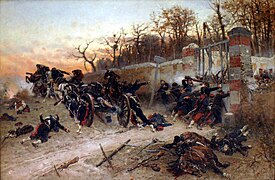Alphonse de Neuville
Alphonse de Neuville | |
|---|---|
 Alphonse de Neuville in a Woodburytype (c. 1880) | |
| Born | Alphonse-Marie-Adolphe de Neuville 31 May 1835 |
| Died | 18 May 1885 (aged 49) Paris, France |
| Known for | Painting |
| Movement | Academic art |
Alphonse-Marie-Adolphe de Neuville (French pronunciation: [alfɔ̃s maʁi adɔlf də nøvil]; 31 May 1835 – 18 May 1885) was a French academic painter who studied under Eugène Delacroix. His dramatic and intensely patriotic subjects illustrated episodes from the Franco-Prussian War, the Crimean War, the Zulu War, and portraits of soldiers. Some of his works have been collected by the Hermitage Museum in St. Petersburg and by the Metropolitan Museum in New York.
Early life

Born Alphonse-Marie-Adolphe Deneuville to wealthy parents at Saint-Omer, Pas-de-Calais, he earned his degree of bachelier ès-lettres, and in 1856 entered the naval school at Lorient in spite of family opposition. It was there that his artistic instincts started.[1]
The young Alphonse de Neuville was discouraged by several painters of repute, but he was admitted to work in the studio of François-Edouard Picot. He did not remain there long. He was already painting by himself when he produced his first picture, The Fifth Battalion of Chasseurs at the Gervais Battery (Malakoff). In 1860, Neuville painted an Episode of the taking of Naples by Garibaldi for the Artists' Club in the rue de Provence. In 1861, he sent The Guard Chasseurs in the Trenches of the Mamelon Vert to the Paris Salon.[2]
Illustrator and military artist
Neuville participated in illustrating Pierre-Jules Hetzel's editions of Twenty Thousand Leagues Under the Seas. He also illustrated Le Tour du monde and François Guizot's History of France. At the same time he painted a number of remarkable pictures: The Attack in the Streets of Magenta by Zouaves and the Light Horse (1864), A Zouave Sentinel (1865), The Battle of San Lorenzo (1867), and Dismounted Cavalry crossing the Tchernaia (1869). In these he showed peculiar insight into military life.[2]
He reached the peak of his career after the Franco-Prussian War of 1870-1871. The long-term French reaction was revanchism: a deep sense of bitterness, hatred, and demand for revenge against Germany, especially because of the loss of Alsace and Lorraine.[3] Paintings that emphasized the humiliation of the defeat were in high demand, such as The Spy by de Neuville.[4]
In response, Neuville aimed at depicting episodes of the Franco-Prussian War in his works, and began by representing the Bivouac before Le Bourget (1872). His fame spread rapidly and was increased by The Last Cartridges (1873), memorializing an episode involving the Blue Division of the French marines, in which it is easy to discern the vast difference between the conventional treatment of military subjects, as practised by Horace Vernet, and that of a man who had lived the life that he painted.[2]
Fight on a Railroad (1874) was equally successful, and was followed by the Attack on a House at Villersexel (1875) and the Railway Bridge at Styring (1877). In 1878 (but not at the Great Exhibition), the painter exhibited Le Bourget, the Surprise at Daybreak, The Intercepted Despatch-bearer, and a considerable number of drawings. He also exhibited in London some episodes of the Zulu War.[2] Fifty thousand people paid to see his impression of The Defence of Rorke's Drift (1880), which the infant Art Gallery of New South Wales in Sydney paid a large sum to acquire.[citation needed]
In 1881, he was made an officer of the Légion d'honneur for The Cemetery of Saint-Privat, The Despatch-bearer, and Huns in the Battle of Chalon. During these years Neuville was at work with Édouard Detaille on an important although less artistic work, The Panorama of Rézonville.
Neuville died in Paris on May 18, 1885. At the sale of his works the state purchased the paintings Bourget and Attack on a Barricaded House, as well as watercolor The Parley and the drawing Turco in Fighting Trim, for the purpose of displaying them at the Palais du Luxembourg.[2]
Gallery
- Les dernières cartouches (1873)
- The Defence of Rorke's Drift, oil on canvas painting by Alphonse de Neuville, 1880, Art Gallery of New South Wales. This incident occurred on 22 January 1879, in the Anglo-Zulu War.
- Défense de la porte de Longboyau, 21 octobre 1870 (1879)
- Bivouac après le combat du Bourget, 21 décembre 1870 (1873)
- Bataille de Champigny (1870)
- Battle at the Railway Embankment (1874)
- In the Trenches (1874)
- A Bugler of the Infantry (1876)
- The Attack at Dawn (1877)
- Last Sleep of the Brave, (1879)
- The Spy, (1880)
- The Cemetery of Saint-Privat (1881)
- En avant ! ou Le combat de Chenebier (1884)
- A Cavalryman (1884)
See also
Notes
- ^ Chisholm 1911.
- ^ a b c d e One or more of the preceding sentences incorporates text from a publication now in the public domain: Chisholm, Hugh, ed. (1911). "Neuville, Alphonse Marie de". Encyclopædia Britannica. Vol. 19 (11th ed.). Cambridge University Press. p. 450. This cites Montrosier, Les Peintres militaires (Paris, 1881), "De Neuville," in Gazette des Beaux-Arts (Paris, 1885).
- ^ Varley, Karine (2008). Under the Shadow of Defeat: The War of 1870-71 in French Memory.
- ^ Jay, Robert. "Alphonse de Neuville's 'The Spy' and the Legacy of the Franco-Prussian War," Metropolitan Museum Journal (1984) 19: pp. 151-162 in JSTOR
Further reading

- Chabert, Philippe Gérard. Alphonse de Neuville : l'épopée de la défaite, Paris, Copernic, 1979.
- Jackson, David, 'Zulu War Paintings - Alphonse De Neuville', Journal of the Society for Army Historical Research, Vol. LXIX, No. 277, Spring 1991, pp. 56–57.
- Southey, R. J., 'De Neuville and Isandhlwana', Africana Notes and News, Vol. 19, No. 6, June 1971, pp. 253–254.














